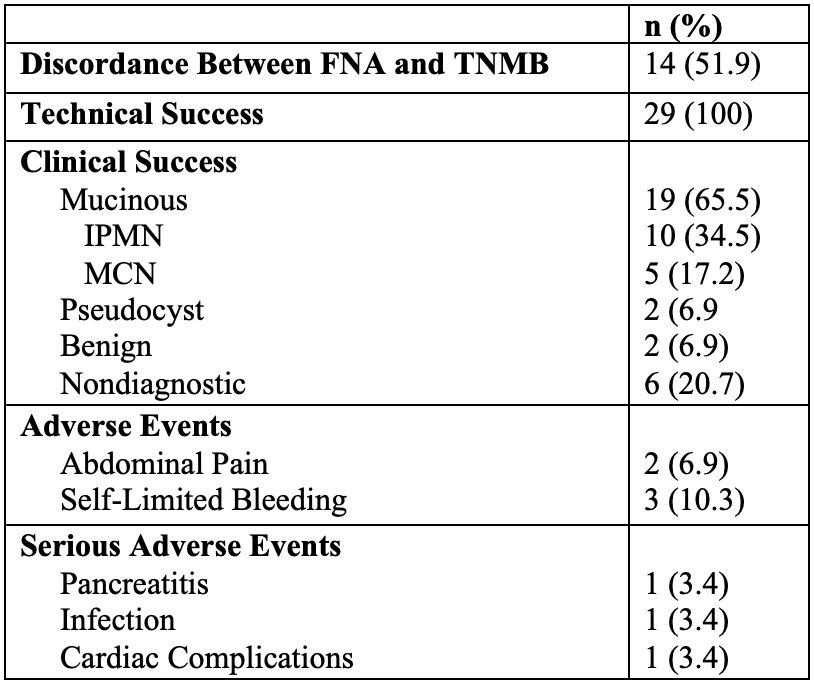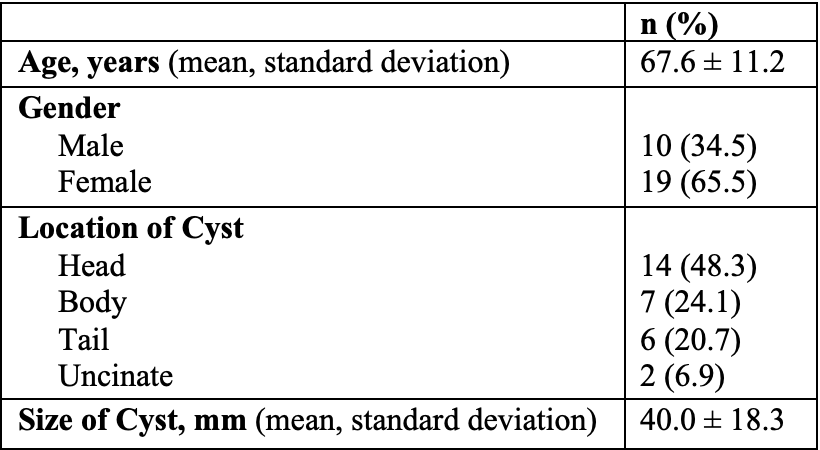Monday Poster Session
Category: Interventional Endoscopy
P3550 - Use of Through-The-Needle Microforceps Biopsies Aids Accurate Diagnosis of Pancreatic Cysts
Monday, October 27, 2025
10:30 AM - 4:00 PM PDT
Location: Exhibit Hall
- JJ
Joel Joseph, MD
Virginia Tech Carilion School of Medicine
Roanoke, VA
Presenting Author(s)
Joel Joseph, MD1, Jonathan Rozenberg, DO1, Noel Puthenveetil, BS2, Varun Kesar, MD1
1Virginia Tech Carilion School of Medicine, Roanoke, VA; 2University of Chicago Medicine, Galesburg, IL
Introduction: Pancreatic cysts are incidentally detected in up to 45% of imaging studies in older populations. Accurate diagnosis is critical given the malignant potential of certain cyst types. Traditional fine-needle aspiration (FNA) is often limited with inconclusive results in 30-60% of cases. Through-the-needle microforceps biopsies (TNMB) under endoscopic ultrasound (EUS) guidance enable direct sampling of cyst wall tissue, potentially improving histological diagnosis. This study evaluates the safety, technical success, and diagnostic effectiveness of TNMB compared to FNA in managing pancreatic cysts.
Methods: This retrospective study evaluated patients at an American tertiary academic medical center who underwent TNMB and FNA for pancreatic cyst assessment. Primary endpoints were the incidence of discordance between TNMB and FNA results and subsequent changes in diagnosis or management. Secondary endpoints included technical success (completion of TNMB and FNA), clinical success (obtaining a diagnostic sample), and 90-day complication rates. Categorical variables were analyzed using chi-square tests, and continuous variables with t-tests, with significance set at p< 0.05.
Results: 29 patients (65.5% female, mean age 67.6 ± 11.2 years) underwent TNMB, with 27 also undergoing FNA of pancreatic cysts (mean size, 40.0 ± 18.3 mm). TNMB findings differed from FNA in 14 of 27 cases (51.9%), resulting in changes to diagnosis and management. Six patients underwent surgical resection, with pathology confirming TNMB findings in 100% of cases. Technical success was achieved in 100% of both TNMB and FNA procedures. Clinical success was significantly higher with TNMB (23/29, 79.3%) than with FNA (13/27, 48.1%; p = 0.01). TNMB identified 19 mucinous cysts, including 10 intraductal papillary mucinous neoplasms, 4 mucinous cystic neoplasms, 2 pseudocysts and 2 benign cysts. Three complications requiring hospitalization were observed in the TNMB group.
Discussion: This study is among the largest single-center North American analyses of TNMB and demonstrates its effectiveness in accurately diagnosing pancreatic cysts and improving diagnostic yield compared to traditional FNA. Furthermore, TNMB is a relatively safe procedure with a high clinical success rate. With the increasing incidence of incidentally detected pancreatic cysts, TNMB may serve as a valuable tool for distinguishing high-risk lesions requiring close monitoring or surgical intervention from low-risk lesions that can be safely observed.

Figure: Table 1: Baseline Characteristics

Figure: Table 2: Outcomes
Disclosures:
Joel Joseph indicated no relevant financial relationships.
Jonathan Rozenberg indicated no relevant financial relationships.
Noel Puthenveetil indicated no relevant financial relationships.
Varun Kesar indicated no relevant financial relationships.
Joel Joseph, MD1, Jonathan Rozenberg, DO1, Noel Puthenveetil, BS2, Varun Kesar, MD1. P3550 - Use of Through-The-Needle Microforceps Biopsies Aids Accurate Diagnosis of Pancreatic Cysts, ACG 2025 Annual Scientific Meeting Abstracts. Phoenix, AZ: American College of Gastroenterology.
1Virginia Tech Carilion School of Medicine, Roanoke, VA; 2University of Chicago Medicine, Galesburg, IL
Introduction: Pancreatic cysts are incidentally detected in up to 45% of imaging studies in older populations. Accurate diagnosis is critical given the malignant potential of certain cyst types. Traditional fine-needle aspiration (FNA) is often limited with inconclusive results in 30-60% of cases. Through-the-needle microforceps biopsies (TNMB) under endoscopic ultrasound (EUS) guidance enable direct sampling of cyst wall tissue, potentially improving histological diagnosis. This study evaluates the safety, technical success, and diagnostic effectiveness of TNMB compared to FNA in managing pancreatic cysts.
Methods: This retrospective study evaluated patients at an American tertiary academic medical center who underwent TNMB and FNA for pancreatic cyst assessment. Primary endpoints were the incidence of discordance between TNMB and FNA results and subsequent changes in diagnosis or management. Secondary endpoints included technical success (completion of TNMB and FNA), clinical success (obtaining a diagnostic sample), and 90-day complication rates. Categorical variables were analyzed using chi-square tests, and continuous variables with t-tests, with significance set at p< 0.05.
Results: 29 patients (65.5% female, mean age 67.6 ± 11.2 years) underwent TNMB, with 27 also undergoing FNA of pancreatic cysts (mean size, 40.0 ± 18.3 mm). TNMB findings differed from FNA in 14 of 27 cases (51.9%), resulting in changes to diagnosis and management. Six patients underwent surgical resection, with pathology confirming TNMB findings in 100% of cases. Technical success was achieved in 100% of both TNMB and FNA procedures. Clinical success was significantly higher with TNMB (23/29, 79.3%) than with FNA (13/27, 48.1%; p = 0.01). TNMB identified 19 mucinous cysts, including 10 intraductal papillary mucinous neoplasms, 4 mucinous cystic neoplasms, 2 pseudocysts and 2 benign cysts. Three complications requiring hospitalization were observed in the TNMB group.
Discussion: This study is among the largest single-center North American analyses of TNMB and demonstrates its effectiveness in accurately diagnosing pancreatic cysts and improving diagnostic yield compared to traditional FNA. Furthermore, TNMB is a relatively safe procedure with a high clinical success rate. With the increasing incidence of incidentally detected pancreatic cysts, TNMB may serve as a valuable tool for distinguishing high-risk lesions requiring close monitoring or surgical intervention from low-risk lesions that can be safely observed.

Figure: Table 1: Baseline Characteristics

Figure: Table 2: Outcomes
Disclosures:
Joel Joseph indicated no relevant financial relationships.
Jonathan Rozenberg indicated no relevant financial relationships.
Noel Puthenveetil indicated no relevant financial relationships.
Varun Kesar indicated no relevant financial relationships.
Joel Joseph, MD1, Jonathan Rozenberg, DO1, Noel Puthenveetil, BS2, Varun Kesar, MD1. P3550 - Use of Through-The-Needle Microforceps Biopsies Aids Accurate Diagnosis of Pancreatic Cysts, ACG 2025 Annual Scientific Meeting Abstracts. Phoenix, AZ: American College of Gastroenterology.
